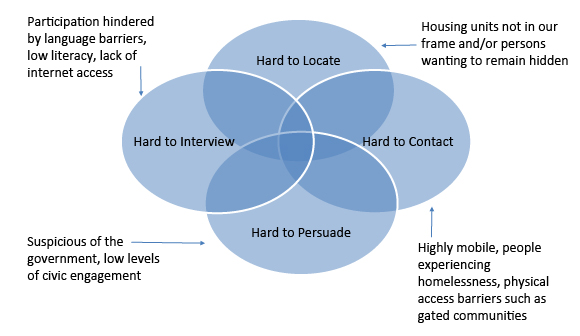Counting Everyone Once, Only Once and in the Right Place
Counting Everyone Once, Only Once and in the Right Place
Last week, U.S. Census Bureau staff presented to the National Advisory Committee (NAC) and gave an update on how we plan to efficiently and effectively reach hard-to-count communities across the country to ensure we have the most accurate count during the 2020 Census.
The chart below provides a quick summary of the way we think about hard-to-count populations. These can include those who are hard to locate, like households that may not appear on our address list or people who may want to remain hidden. Some populations are hard to contact because they are highly mobile, experiencing homelessness or living in gated communities. Hard-to-count populations can be those that are hard to persuade because they lack trust in the government and the way their data will be used. They can also be hard to interview because of language barriers or low internet access. Many people fall under more than one of these designations, which is why we are implementing the most robust outreach effort in the history of the Census Bureau.

Hard-to-count populations can fall into many categories. These include:
- Young children under the age of five.
- Highly mobile people.
- Racial and ethnic minorities.
- Non-English speakers.
- Low income people.
- People experiencing homelessness.
- Undocumented immigrants.
- People who distrust the government.
- LGBTQ persons.
- People with mental or physical disabilities.
- People who do not live in traditional housing.
Conducted in a rapidly changing environment, the 2020 Census requires constant enhancement on our part to do our best to perfect the process. It is more difficult and expensive to count our population, which is why we also work extensively with trusted community leaders to help us understand what makes it difficult for people to respond, and to determine who can help us reach everyone. The 2020 Census belongs to everyone and we need the public’s help to be successful. Together, we can overcome language barriers, distrust in government, as well as fear and lack of knowledge about the census and how it benefits your community.
As an integral component to the 2020 Census Operational Plan our Integrated Partnership and Communications (IPC) Operation will reach every household in the nation. As important as the IPC is to our efforts to count the entire population, it is only one in a series of steps we take to make sure we are reaching everyone.
- We make sure to identify where people live when we build our address list. This includes what we call “hidden housing units,” housing units that may not be easy to identify — if we are unable to locate a housing unit, we cannot count the occupants. The training for our staff includes clues for identifying hidden housing units, as well as instructions on inquiring about hidden housing units. Our Local Update of Census Addresses Operation, underway now, provides the opportunity for tribal, state and local governments to review and provide input on the Census Bureau’s address list.
- We start the 2020 Census count early in January 2020, with a special operation designed for Northern Alaska. We know we can only reach the population living there when the tundra is frozen and people are reachable in their villages. We also work in partnership with village elders to identify and hire enumerators who speak the local language and can translate and facilitate the collection of census response data.
- We will make it as easy as possible for people to be counted. When the 2020 Census begins in March 2020, for the first time we will offer three response options: internet, telephone and paper. People can respond in 12 non-English languages over the phone or via the internet.
- We will hand deliver the 2020 Census packages to areas without standard mailing addresses because we know that we cannot use our standard procedures in these areas. We will also do this in areas hit by natural disasters like Puerto Rico and parts of Florida and North Carolina that were devastated by hurricanes, and areas in California ravaged by forest fires.
- Census takers will knock on the door of those who do not respond. They will be hired from the communities they work in so that they are familiar with, and speak the language of, the neighborhoods where they are working.
- We have a special operation for people who live in prisons, nursing homes, college/university housing and other group homes, known as the “Group Quarters Operation.” We work with the administrators of these facilities ahead of time so that they can assist us in making an accurate count.
- We go to great lengths to count those who are experiencing homelessness. We work with our partners to identify service-based locations like emergency and transitional shelters, soup kitchens, mobile food vans and targeted nonsheltered outdoor locations, which include sites under bridges and cemeteries. We then implement specially designed operations to count the people we find in these places.
Understanding the communities who have traditionally had low response rates is critical for the success of the 2020 Census, and these are just a few of the ways we account for the different ways people live in our country and respond to the census. Reaching the hard-to-count is woven into the entire design of the 2020 Census. Our partners and local leaders are key and by working with them, we will do everything we can to count everyone once, only once and in the right place.
To view the full presentation and other presentations from the 2018 Fall NAC meeting, click here.



